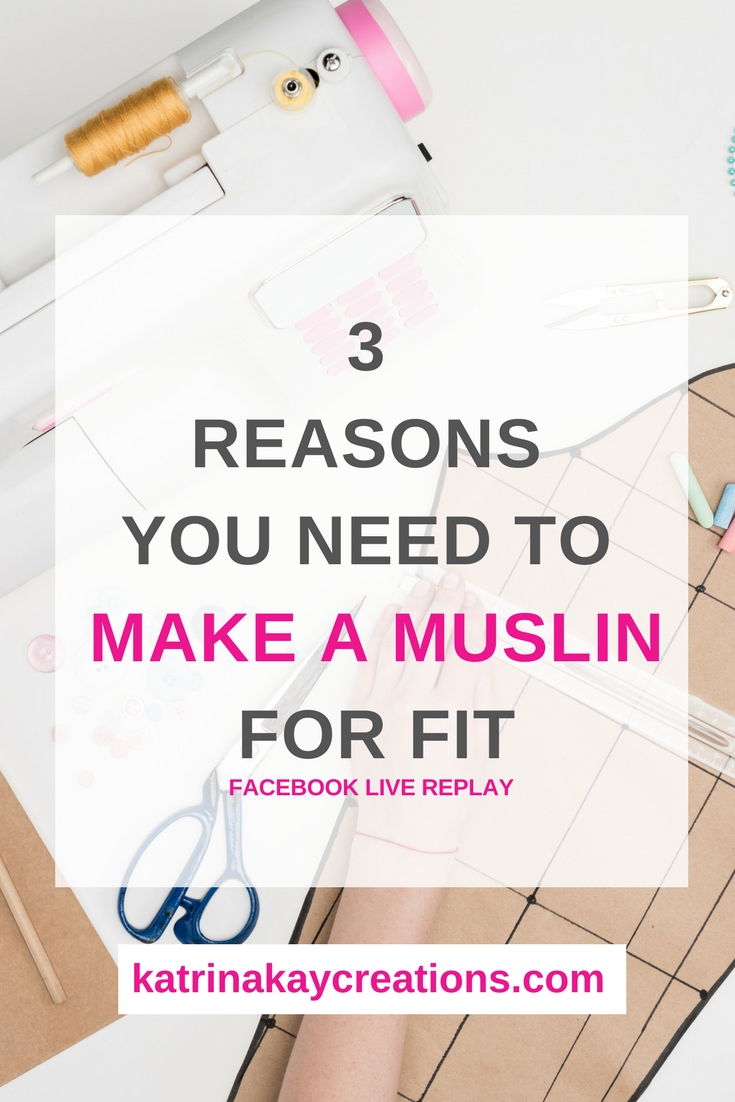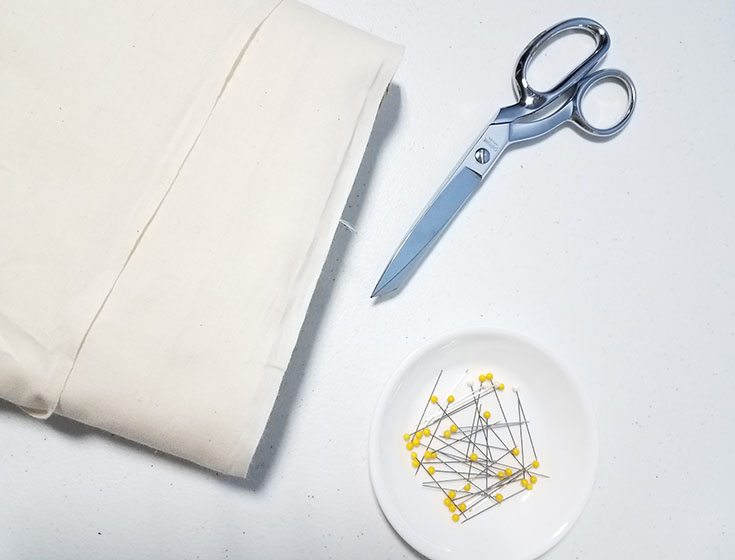 To make a muslin (test garment) or not to make a muslin, some say yes and some say no. It really depends on who you talk to. Many people want to skip making a muslin because they don’t feel it’s necessary. That’s not to say it’s necessary in every case. But when you’re not sure if you’re pattern is going to fit your body measurements or body shape, a muslin is necessary. Today I’m going to give you 3 reasons you need to make a muslin for fit. And by fit I mean test fitting a garment made from your pattern to avoid ruining your good fabric.
To make a muslin (test garment) or not to make a muslin, some say yes and some say no. It really depends on who you talk to. Many people want to skip making a muslin because they don’t feel it’s necessary. That’s not to say it’s necessary in every case. But when you’re not sure if you’re pattern is going to fit your body measurements or body shape, a muslin is necessary. Today I’m going to give you 3 reasons you need to make a muslin for fit. And by fit I mean test fitting a garment made from your pattern to avoid ruining your good fabric.
Related Post: 7 Ways to Make Solo Fitting Easier
What is a muslin?
I don’t want this to get confusing so let me explain. Muslin fabric is the bleached or unbleaced cotton fabric used to make a test garment. The test garment is called a muslin, named after the fabric.
Unless you’ve sewn a pattern before and already altered it to fit your body, you cannot be 100% sure that the pattern is going to fit.
And unfortunately, in most cases, the pattern doesn’t fit without adjustments.
Do you want to avoid wasting your good fabric and money? Your muslin will show you fitting problems that can and can’t be fixed after your garment is made. You can make the changes to your pattern and make a final garment that fits.

This is muslin fabric, unbleached, purchased in JOANN Fabrics & Craft Store. This is not the only fabric that can be used to make a muslin.
Some people think it a waste of time and fabric to make a test garment.
What if the pattern fits good and only needs minor changes? Then I’ve just wasted my time.
It’s not a waste of time to guarantee a good fit. What if you need major changes? You’ll know from the fit of your muslin.
Why make something you’re not going to be able to wear? Now I’ve wasted fabric.
Not true. Any fitting issue the muslin makes you aware of gives you the opportunity to fix it. And if you can fix the problem, the result will be a wearable garment you can be proud of.
What do I do with the muslin/test garment after it’s no longer needed?
You can use the muslin/test garment to test decorative stitches for future projects, cut them up to use as press cloths or cut them up to make your own pillow forms or use as the stuffing. Add old muslins to the scrap pile-you’ll never know what possible uses will come up.
Let’s think about what our end goal is. Our end goal is to make a garment that fits our curves.
So if our test garment helps us tweak the fit and shows us the type of alterations we need, then it’s not wasted fabric or wasted time.
Here are 3 reasons you need to make a muslin for fit:
1. To determine fitting problems that measurements can’t predict.
Measurements cannot determine how a garment will fit your shape. We could all be the same dress size but have different shapes and proportions.
Commercial patterns companies can’t predict the type of fitting problems you may have. Your body may be asymmetrical or you may not need as much ease as the pattern company built into their pattern. Your muslin will show there’s a fitting problem by the way it looks and feels.
There are some fitting problems you’re not going to see or feel until you put on the garment. Also, you won’t be able to fix some fitting problems after the garment is sewn. They need to be fixed on the pattern before you cut your good fabric.
2. To make sure design details work for your body.
Have you ever bought a really cute pattern only to find out the design doesn’t do anything to flatter your curves? Or that the actual garment doesn’t look or work quite like the pattern? If you’ve made it out of your good fabric and you’re not thrilled with it, you’re probably not going to wear it. And if you do wear it, are you really going to feel good in it? Probably not.
You need to know that the design details of the pattern fall in the right place on your body. If an empire waist falls right across your bust instead of under your bust, your muslin will show you that your pattern needs to be fixed before you cut. That’s a hard fix after the final garment is sewn, without adjusting the pattern and re-cutting.
You can mark right on a muslin and transfer your adjustments to your pattern. Mark things like where a new seam should go or where gathers or pleats should start and end.
You should also mark basics things like bust, waist and hip lines to make sure they’re in the right place on your body.
3. To make changes to your pattern once and not with each use.
Don’t get comfortable with just making adjustments as you sew because this is really counter-productive.
Most of us wish we had more time to sew. Spending time making changes as we sew or making changes only to our finished garment is a waste of that precious sewing time.
If I only make changes to my finished garment, then every time I use that pattern, I’m going to have to make the same changes.
If you make a muslin and make the adjustments you need on your pattern, you only have to do those alterations once. Every time you use that pattern, you’ll no longer have to worry about fixing your garment. You can use your pattern over and over again knowing it’s going to fit.
What kind of fabric should you use for a test garment?
- You can use the bleached or unbleached cotton muslin fabric.
- If you find remnants at discounted prices, they can be put to good use as a test garment.
- Old sheets will work also.
- I also use the old, dated fabric in my stash because it’s perfect for testing fit.
You don’t have to use muslin fabric only. Just make sure it’s a solid color and not a busy print so you can actually see the fitting problems.
I buy muslin fabric when it’s on sale and I get 10 yards because that usually lasts a long time. Keep an eye out for those nice sales around holidays or for discounted out of season fabrics.
Also, use fabric for testing that’s similar to the weight and drape of your final fabric. This will give you a more accurate assessment of how your final garment will fit.
Make as many test garments you need to until you get a nice, comfortable fit. Even if you have to make multiple muslins for the same pattern to get the right fit, you still benefit. You’ll learn a lot about altering a pattern and get a pattern that fits your curves.
The video below is an edited replay version of the Facebook LIVE I did about making a muslin. To see the unedited versions (videos 3 & 4), click HERE.
Final words…
In the long run, making a muslin will save you time and money. And you’ll have a lot more garments hanging in your closet instead of in the scrap pile.
Are you a “yes to muslin” person or a “no to muslin” person? Let me know in the comments.
Am Short and also Short wasted I were a size 16-18 .women. The in seame is 25″and my out size seam is 36. I buy short pants when I can fine them . Way do. they make paints so long leg . Why don’t they make clothes for short. People I hate buying paints then I have to cut them up to fit me .thank you for listening Bev M
I understand your problem, Beverly. Everything I buy is too long. I’m glad to listen any time because I know your frustration. Thanks for sharing.
So far I’ve only made one garment that needed to be close-fitting (the detached bodice of a dress – not for myself), and I made a muslin for that. You’re so right! It was a VERY good thing I had a muslin, because the fit was all wrong, and I had to make adjustments on every seam, as well as shortening the whole thing by about 2-3 inches! One thing I was glad of was that I sewed the two front pieces together, and the back and side-back pieces together, and then to fit the bodice I pinned the shoulder and side seams. That made it a lot easier to adjust to fit the girl.
One thing my mom has done (if the top is to be lined) is to make the muslin out of the lining fabric, pinning seams instead of stitching where possible, and then using those adjustments to alter the pattern. That takes care of what to do with it!
I think what some don’t realize, Lorraine, is that you don’t have to sew the muslin like you would the finished garment. You just need to sew enough to give you something to try on so you can assess the fit. It was such a good idea to just pin the shoulders and side seams so you could adjust them as needed. And your mother making the muslin out of the lining-I love that. Thanks so much for sharing.
Thank you for sharing your expertise. I am older and my body has changed. I always make a muslin, it saves money in the long run!
Yes it does, Linda. I can’t imagine putting the time and effort into a garment only to get something that doesn’t fit as a result. Thanks for taking the time to comment.